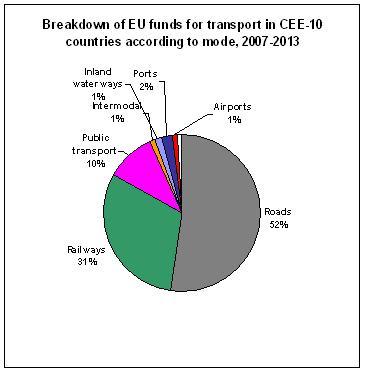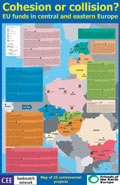EU funds for climate-friendly energy and transport!
Energy |
Transport |
|
|
EU Funds in central and eastern Europe: Cohesion or Collision? |
Friends of the Earth Europe and CEE Bankwatch Network are monitoring the new EU member states' plans for the use of EU Structural and Cohesion funds in the energy and transport sectors over the next seven years. The analysis is being continuously updated based on new governments' plans in collaboration with our NGO colleagues in central and eastern Europe. Updated reports are regularly posted on this website for download.
The analysis shows that not enough is being done to promote energy efficiency, renewable energy, and environment-friendly public transport in the new member states. Friends of the Earth Europe and CEE Bankwatch Network are urging the Commission and the member states to revise their spending plans before they are finalised in the next few months:
EU funds for efficient and renewable energy
Central and eastern Europe has grossly wasteful energy usage and vast, unexploited potential for renewable energy. For every euro of gross domestic product, CEE countries consume 50 percent more energy than western Europe, which works as a drag on their economies. Investments in energy savings would reduce energy bills for schools, hospitals, municipalities, households and businesses.
The share of renewable energy in electricity consumption in the new member states is only 6 percent as opposed to 15 percent in the EU-15 countries. A funding spur for decentralised wind, solar or biomass energy projects would create new jobs, provide a boost to local economies and cut their dependency on external energy sources.
However, only 2.5 billion Euros (less than two percent) of the total EU funding allocation of 157 billion Euros for the new member states and acceding countries in 2007-2013 is planned for investment in sustainable energy projects.
Poland and Hungary are the most worrying cases, planning to spend less than one percent of their EU money on energy efficiency and renewable energy projects (see chart). In contrast, Lithuania is planning to invest six percent of its future EU funding in such projects.

The draft spending plans of most new member states ridicule the EU's newly reformed cohesion policy, which emphasises energy efficiency and renewable energy as one of the top investment priorities for the Structural and Cohesion funds.
The record of Structural and Cohesion funds on climate change up until now has been an unequivocal failure. The four countries that have so far received the most EU money - Spain, Portugal, Greece and Ireland - have also witnessed by far the greatest increases in greenhouse gas emissions in the EU.
Greenhouse gas emissions dropped significantly in Central and Eastern European countries in the 1990s due to economic restructuring, but they are now rapidly rising again and are set to increase by 11 percent by 2010.
Friends of the Earth Europe and CEE Bankwatch Network are urging the Commission and the member states to revise the plans before they are finalised in the next few months:
|
The report is endorsed by associations of European cities promoting sustainable energy (Energie-cites), the renewable energy industry (EREC) and Europe's leading companies manufacturing energy saving products (EuroAce).
For more information, download the report Channelling EU funds into efficient and renewable ENERGY: Comparison of energy measures and allocations in the draft Operational Programmes of CEE countries for the 2007-2013 period.
EU funds for public and environment-friendly transport
The new member states can still avoid the vicious circle – familiar across western Europe – of ever increasing car dependency, noise and air pollution, urban sprawl, chronic congestion, and further road building. The share of freight transported by rail and of passengers transported by public transport in the new member states is still considerably higher than in the old member states, although it has declined in favour of trucks and cars in recent years. Money has been poured into building new motorways that serve lorries, while motorway fees cover only a minimal part of their costs. At the same time, public transport and railways have suffered from under-investment and increasingly expensive charges for their usage.
The number of cars per person is already higher in the Czech Republic, Lithuania and Slovenia than in one of Europe’s richest countries, Denmark. As a result of the increasing car and truck traffic, emissions from the transport sector in central and eastern Europe have increased by 35 percent over the last ten years and are the main cause of the overall emissions now rising again.
 This trend must be reversed through the focused investment of EU funds into modernising railways and public transport in cities, suburbs as well as rural areas.
This trend must be reversed through the focused investment of EU funds into modernising railways and public transport in cities, suburbs as well as rural areas.
Buses and trams produce 3-4 times less CO2 emissions per passenger than private cars. In addition, the number of people seriously injured and killed per driven passenger-kilometres is 10-20 times lower for collective transport than for cars. In cities, public transport uses valuable urban space much more economically than cars. Cars also cause excessive noise and air pollution and lead to congestions which annually cost billions of euros of damage to Europe's economy. Mobility of large categories of people who do not have access to a car – usually lower-income or older people, women, children – is totally dependent on public transport.
As for motorways, a number of studies have undermined the widespread myth that they spur economic development. Economic impacts are as often positive as negative, depending on specific circumstances of a given region. Moreover, this does not include the negative external costs of transport, such as noise, damage to health and climate change impacts, which are estimated at more than seven percent of the EU's gross domestic product.
However, the central and eastern European countries plan to invest much more EU funding into roads and motorways - more than 20 billion Euros - than into any other form of transport (see chart to the left). Public transport is due to receive five times less money.
Romania, Slovenia, Slovakia, and Lithuania are the worst culprits, planning almost no or just piecemeal funding support for public transport, even though it is one of the EU's official investment priorities (see chart to the right). Even in the other countries, the planned investments in public transport are usually not comprehensive or are only concentrated in the capital city.
Friends of the Earth Europe and CEE Bankwatch Network are urging the Commission and the member states to revise the plans before they are finalised in the next few months:
At least 75 percent of all transport funding in each member state should be allocated for environmental-friendly transport investments:
|
The report is endorsed by the International Association of Public Transport (UITP) - European Union Committee.
For more information, download the report EU funds for public and environmental-friendly TRANSPORT: Comparison of transport measures and allocations in the draft Operational Programmes of CEE countries for the 2007-2013 period.
For more information on what the new member states are preparing for the 2007 – 2013 period, contact: billions@foeeurope.org


